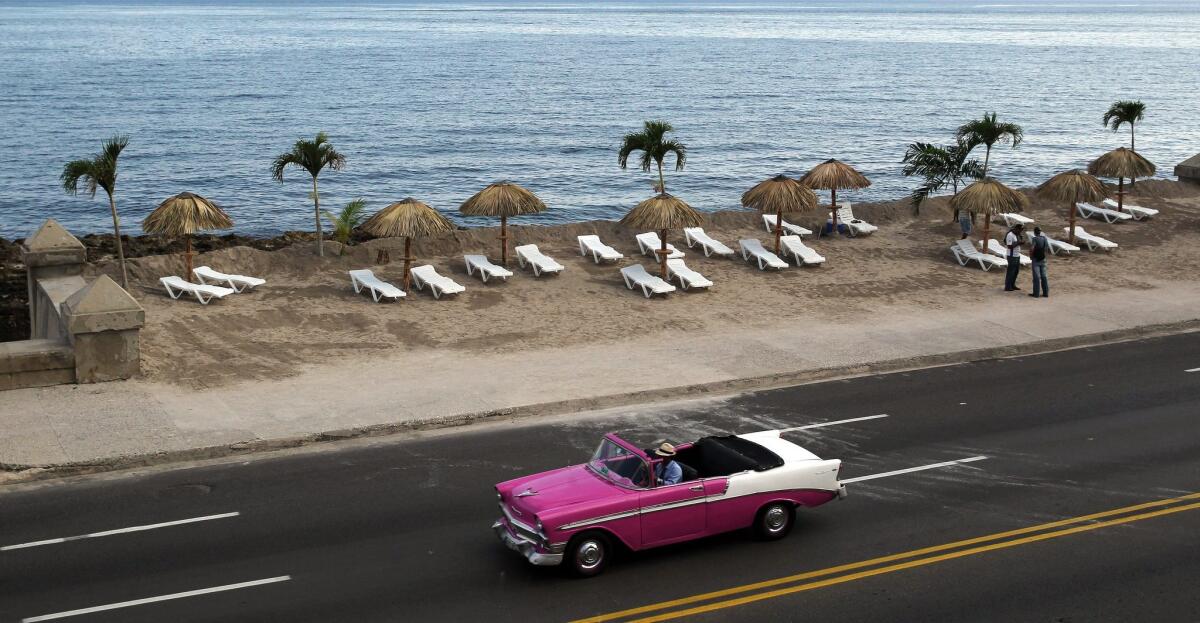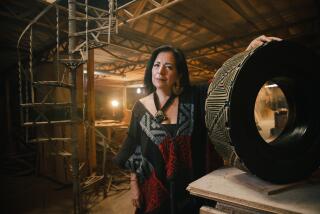‘Cultural feeding frenzy’: Art world descends on Cuba for Havana Biennial

A car passes in front of an installation titled “Resaca” by Cuban artist Arles del Rio, part of the 12th Havana Biennial in Cuba. The artist transformed a patch of boardwalk into a beach.
- Share via
Rosa Lowinger has been getting the invitations at a rate of two a day. The Los Angeles-based sculpture conservator, who writes frequently on Cuba and leads art and architectural tours of the country, is in the Cuban capital for the opening of the latest edition of the Havana Biennial. And the mood, she says, is frenetic.
“There are exhibits in every corner of the city: performances, collectives, interventions, you name it,” she stated via email from Havana on Thursday. “It feels like the Monday night before Art Basel in Miami. The parties have already started with the Norwegian and Swiss embassies holding bashes for artists and VIPs.”
Friday marked the opening of the 12th edition of the Havana Biennial, an event that has the art world abuzz. First launched in 1984 as an exhibition devoted to showcasing the the works of artists from Latin America, it has since morphed into a sprawling international affair with plenty of ancillary events. In the last half dozen years, it has attracted collectors, curators and arts writers from all over the U.S. and Europe who jet to Havana to see and buy art.
But this year, it is freighted with a special anticipation. For this year’s edition represents the first iteration of the biennial in the wake of the the recent political rapprochement between the U.S. and Cuba.
Darel Couturier, who runs Couturier Gallery on La Brea Avenue, says interest among collectors and museum patrons has been sky high.
“I’ve been to all the biennials since 1997,” he said via telephone shortly before departing for Cuba on Wednesday. “The artists there are very excited and they’re going all out. They’re looking at cultivating a better connection to the art world.”
Couturier is taking a group of 23 people for what promises to be a jampacked schedule of exhibition openings and studio visits. His group includes various board members from the University of Oregon’s Jordan Schnitzer Museum of Art, most of whom are going to Cuba for the first time.
Adolfo Nodal, who runs Cuba Tours and Travel, an agency based out of Long Beach, has organized trips for 350 people around the Havana Biennial.
“We have major collectors, we have endowed museums, we have curators and we have artists who want to see what’s going on,” he said via telephone from Miami as he made his way to Havana. “We’ve had so much interest in the Biennial. And we have another trip in December, for the Havana Jazz Festival. That trip sold out in one week — that’s 150 people in a week.”
Lowinger, who is in Havana leading a group from the American Institute for Conservation — the vast majority of them first-timers — says interest in Cuba exploded the moment President Obama and Raul Castro made their historic announcement in December.
“I get constant emails and calls,” she says. “People say, ‘Will you put me on your mailing list for Cuba travel? I don’t even have a mailing list.”
There is also a significant U.S. institutional presence in Havana for the biennial.
New York’s Bronx Museum of the Arts has teamed up with Cuba’s Museo Nacional de Bellas Artes (National Fine Arts Museum) for an exhibition titled “Wild Noise,” which features more than 90 works by 50 artists from the Bronx Museum’s permanent collection — on view for the first time in Havana. (In exchange, the Bronx Museum will host a show of objects from the MNBA’s permanent collection in the U.S. in 2016.)
Glenn Philips, a contemporary art curator at the Getty Research Institute, is going to Cuba for the first time this week to research the development of video art in the country — part of a years-long project about the history of Latin American video art.
“Cuba was so important to the development of the form in other countries,” he says. “Yes, we’ll be going to the biennial, but we’ll also be doing a lot of studio videos and research.”
Among the international artists already displaying work around the biennial are South Korea’s Han Sungpil, who did an outdoor photo installation; Nigeria’s Victor Ekpuk, who is doing an on-site mural using only white chalk on a wall at Havana’s Wifredo Lam Centre of Contemporary Art; and India’s Nikhil Chopra, who is spending 60 hours inside a cage on a Havana street as a piece of politically minded performance art. (See more artists and activities from the biennial in the slide show with this post.)
While there is a lot of excitement about the artists arriving for the biennial and the Cuban art scene, there is still concern about questions of freedom of speech for the Cuban artists inside the country — in particular, the case of artist Tania Bruguera, who was detained by Cuban authorities on multiple occasions earlier this year after trying to stage a performance about free expression in a public plaza. Since then, she has been in a legal limbo, unable to leave the country after the Cuban authorities confiscated her passport.
In recent weeks, there had been online chatter about a boycott of the biennial. And at least one person, Lima, Peru-based curator Gustavo Buntix, did bow out over Bruguera’s treatment. But for the most part, preparations for the biennial have carried on undisturbed.
John Spiak, the director of the Grand Central Art Center in Santa Ana, says this was an issue he gave careful thought to before he made the decision to go.
“I’ve really thought about what traveling there means,” he says. “I think Tania is fantastic. And I really respect her work. But I also think it’s important to have a certain openness about this, to support artists working on the island. I think you find that, time after time, isolation doesn’t really work.”
Nodal, who was born in Cuba and has lived in Los Angeles since the late 1980s, says he supports the idea of travel.
“There are problems in Cuba, obviously,” he says. “I don’t support that. But I do support Americans going to Cuba. I think that can make things change.”
Bruguera, for her part, announced that she would stage a work of performance on Wednesday, in advance of the biennial. The piece, titled “Hannah Arendt’s International Institute of Artivism,” would consist of the reading and discussion of a text about totalitarianism by political theorist Hannah Arendt over a period of 100 hours.
Whether Bruguera was able to complete the piece is unknown. A Facebook status update posted by her sister, Deborah, on Friday, reported that Tania had been visited by police in advance of the performance. She also reported the arrival of workmen to the block, who began jack-hammering outside of Bruguera’s building as the reading was set to take place.
None of this seems to be making waves at the biennial. The global collector class has touched down in Havana, and they are ready to acquire.
“The name of the game here is definitely commerce,” the conservator Lowinger writes. “The trips all include studio visits and artists are setting themselves up to receive tour buses full of people who frantically want to buy Cuban art ‘before the country changes’ — whatever that means.”
She adds: “It’s a cultural feeding frenzy, for sure.”
Find me on Twitter @cmonstah.
More to Read
The biggest entertainment stories
Get our big stories about Hollywood, film, television, music, arts, culture and more right in your inbox as soon as they publish.
You may occasionally receive promotional content from the Los Angeles Times.











